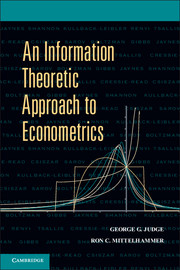Book contents
- Frontmatter
- Contents
- Preface
- One Econometric Information Recovery
- Part I Traditional Parametric and Semiparametric Econometric Models: Estimation and Inference
- Part II Formulation and Solution of Stochastic Inverse Problems
- Part III A Family of Minimum Discrepancy Estimators
- Part IV Binary–Discrete Choice Minimum Power Divergence (MPD) Measures
- Part V Optimal Convex Divergence
- Eleven Choosing the Optimal Divergence under Quadratic Loss
- Twelve Epilogue
- Abbreviations
- Index
- References
Eleven - Choosing the Optimal Divergence under Quadratic Loss
from Part V - Optimal Convex Divergence
Published online by Cambridge University Press: 05 June 2012
- Frontmatter
- Contents
- Preface
- One Econometric Information Recovery
- Part I Traditional Parametric and Semiparametric Econometric Models: Estimation and Inference
- Part II Formulation and Solution of Stochastic Inverse Problems
- Part III A Family of Minimum Discrepancy Estimators
- Part IV Binary–Discrete Choice Minimum Power Divergence (MPD) Measures
- Part V Optimal Convex Divergence
- Eleven Choosing the Optimal Divergence under Quadratic Loss
- Twelve Epilogue
- Abbreviations
- Index
- References
Summary
Introduction
In econometric practice, the underlying data sampling process is seldom known. This lack of information has a potential impact on estimator performance and thus the precision of information recovery. A basic limitation of traditional likelihood-divergence approaches is that it is impossible to describe estimators-distributions of an arbitrary form. In this chapter, we recognize this estimation and inference problem and propose a loss function approach to choosing an optimum choice rule from a family of possible likelihood estimators. The resulting optimal likelihood function-estimator combination involves, given a loss function, a convex combination of likelihood functions from the Cressie-Read (CR) family of power divergence measures (PDM) that were introduced and analyzed in Chapters 7 through 10.
The basis for choosing a loss-based choice rule comes from questions asked by Gorban (1984), Gorban and Karlin (2003), and Judge and Mittelhammer (2004). Gorban and Karlin asked which density distributions will emerge if we take a convex combination of two entropy functionals, which, in our context, refers to two members of the CR family. Judge and Mittelhammer asked which combination of econometric models will emerge if we take a convex combination of two design matrices-models, using a quadratic loss choice rule. In this chapter, we change the question and ask which estimation rule will emerge from the CR family of likelihood functions if we take a convex combination of two or more members of the CR family (two or more γs), subject to a squared error-quadratic loss measure. In the sections that follow, we develop a framework for seeking an answer to this question. A sampling experiment is used to illustrate the performance of the resulting estimation-choice rules.
- Type
- Chapter
- Information
- An Information Theoretic Approach to Econometrics , pp. 207 - 220Publisher: Cambridge University PressPrint publication year: 2011



